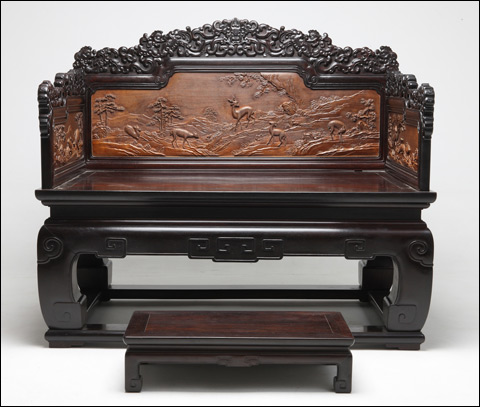
THRONE: You may be tempted to bow before the seat of power. |
Salem's Peabody Essex Museum has pulled off the curatorial coup of the year with "The Emperor's Private Paradise," which reveals to the public for the first time 90 "treasures from the Forbidden City," the Chinese imperial palace in Beijing. Says Peabody Essex director Dan Monroe, "The loan of works for the exhibition is the largest of its kind out of the Palace Museum."
Credit Peabody Essex Chinese-art curator Nancy Berliner. It's a feat of diplomacy and connoisseurship rivaled locally in recent years only by the Museum of Fine Arts' 2009 "Titian, Tintoretto, and Veronese" blockbuster. It came about because Berliner is an insider — she's serving as a curatorial adviser to the World Monument Fund project to restore the Forbidden City's Qianlong Garden (the show's "private paradise"). Work began in 2001 and is scheduled to be finished in 2019. From here, the show travels to New York's Metropolitan Museum of Art.
The ruler in question is the Qianlong emperor (1711–1799; ruled 1735–1796), master of what exhibit organizers call the "world's largest and wealthiest empire" of its time. He was an æsthete who wrote 40,000 poems, as well as a conqueror who defeated Mongols in 1760 to expand China by a third — at its peak it encompassed 4.6 million square miles (as opposed to the 3.7 million square miles it occupies today). By the mid 18th century, his subjects totaled 179 million. Compare that to the 140 million residents in Europe (including Russia and Turkey) and then two million across North America. His reign is considered the longest in Chinese history.
"In my eighties, exhausted from diligent service,/I will cultivate myself, rejecting worldly noise," he wrote in 1776. Between 1771 and that year, the Qianlong emperor had built the retirement sanctuary in which he would do so. The Qianlong Garden is 27 pavilions, densely but carefully arranged along a series of courtyards filled with bamboo groves, artificial mountains, and curving waterways on two acres of the northeastern section of the Forbidden City. It was meant to be his private imperial quarters for Buddhist meditation, writing poetry, and contemplation. But he used it only occasionally, because when the time for retirement came, two decades later, he retained a hand on the reins of power, despite having officially abdicated.
The aged Qianlong emperor stares out from an eight-foot-tall, life-size, ink-and-color portrait on silk. The monumental figure, dressed in gold ceremonial dragon-patterned robes, seems to hover in the air over his dragon throne. His face is serious, tired, old, skeptical, impassive.
It is a rare painting among the tables and chairs and thrones dramatically installed here. The exhibit opens with a 16-panel screen given to the emperor by a provincial governor who was later sentenced to death for corruption. One side is a copy after the revered ninth-century artist Guanxiu's paintings of Sixteen Luohan at a monastery in Hangzhou. The Buddhist disciples are rendered in bone white on black as grotesque, enlightened, wrinkled old coots. Guanxiu's sequence was a favorite of the emperor's, so for centuries the backside of it has been hidden, pressed against the wall of the garden's Building of Luminous Clouds. Berliner reveals the hidden side, a series of gold plants against a black background, picked out with fine lines and seemingly glowing from within.